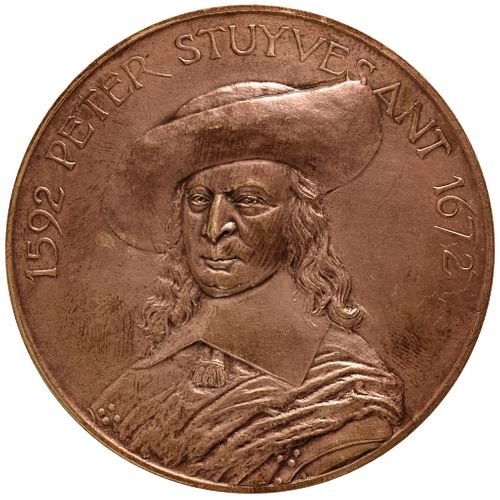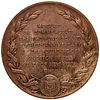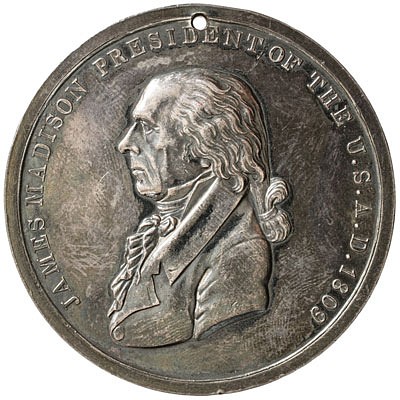Tiffany + Co., 1907 Kingston, NY. Peter Stuyvesant, Bronze Commemorative Medal
Lot 297
Categories
Estimate:
$400 - $500
Absentee vs Live bid
Two ways to bid:
- Leave a max absentee bid and the platform will bid on your behalf up to your maximum bid during the live auction.
- Bid live during the auction and your bids will be submitted real-time to the auctioneer.
Bid Increments
| Price | Bid Increment |
|---|---|
| $0 | $10 |
| $200 | $20 |
| $300 | $25 |
| $500 | $50 |
| $1,000 | $100 |
| $2,000 | $200 |
| $3,000 | $250 |
| $5,000 | $500 |
| $10,000 | $1,000 |
| $20,000 | $2,000 |
| $30,000 | $2,500 |
| $50,000 | $5,000 |
| $100,000 | $10,000 |
| $200,000 | $20,000 |
| $300,000 | $25,000 |
| $500,000 | $50,000 |
About Auction
By Early American History Auctions
Jul 24, 2021
Set Reminder
2021-07-24 12:00:00
2021-07-24 12:00:00
America/New_York
Bidsquare
Bidsquare : A Revolutionary Numismatic Auction
https://www.bidsquare.com/auctions/early-american-history-auctions/a-revolutionary-numismatic-auction-7186
A Revolutionary Numismatic Auction Early American History Auctions auctions@earlyamerican.com
A Revolutionary Numismatic Auction Early American History Auctions auctions@earlyamerican.com
- Lot Description
Medals
Tiffany & Co. 1907 Kingston, New York Bronze Medal Commemorating the City's 250th Anniversary of Founding
1907 Kingston, New York Bronze Medal, Engraved and Struck by Tiffany & Co. in Bronze, Commemorating the 250th Anniversary of the Founding of the City with Portrait Bust of Peter Stuyvesant. Choice Uncirculated.
63 mm. A wonderful historical Commemorative medal. Displays, Obverse: Portrait Bust of Peter Stuyvesant shown in his broad-brimmed period hat. Reverse: Wreath and Seal of Novum Belgium enclose commemorative inscription. "Tiffany & Co." appears in small letters at bottom right. Smooth hard satiny surfaces having a light copper-bronze pleasing appearance. A lovely turn-of-the-century example by Tiffany & Company.
Kingston is a City in and the county seat of Ulster County, New York, United States. It is 91 miles (146 km) north of New York City and 59 miles (95 km) south of Albany. The city's metropolitan area is grouped with the New York metropolitan area around Manhattan by the United States Census Bureau. It became New York's first capital in 1777. During the American Revolutionary War, the city was burned by the British on October 13, 1777, after the Battles of Saratoga.
In the 19th century, the city became an important transport hub after the discovery of natural cement in the region. It had connections to other markets through both the railroad and canal connections.
Many of the older buildings are considered contributing as part of three historic districts, including the Stockade District uptown, the Midtown Neighborhood Broadway Corridor, and the Rondout-West Strand Historic District downtown. Each district is listed on the National Register of Historic Places.
Peter Stuyvesant (in Dutch also Pieter and Petrus Stuyvesant; c. 1592 - August 1672) served as the last Dutch director-general of the colony of New Netherland from 1647 until it was ceded provisionally to the English in 1664, after which it was split into New York and New Jersey with lesser territory becoming parts of other states. He was a major figure in the early history of New York City and his name has been given to various landmarks and points of interest throughout the city (e.g. Stuyvesant High School, Stuyvesant Town, Bedford-Stuyvesant neighborhood, etc.).
Peter Stuyvesant's accomplishments as Director-general included a great expansion for the settlement of New Amsterdam beyond the southern tip of Manhattan. Among the projects built by Stuyvesant's administration were the protective wall on Wall Street, the canal that became Broad Street, and Broadway.
Stuyvesant, himself a member of the Dutch Reformed Church, opposed religious pluralism and came into conflict with Lutherans, Jews, Roman Catholics, and Quakers as they attempted to build places of worship in the city and practice their faiths.
- Shipping Info
-
Early American provides in-house worldwide shipping. Please contact us directly if you have questions about your specific shipping requirements.
-
- Buyer's Premium



 EUR
EUR CAD
CAD AUD
AUD GBP
GBP MXN
MXN HKD
HKD CNY
CNY MYR
MYR SEK
SEK SGD
SGD CHF
CHF THB
THB












